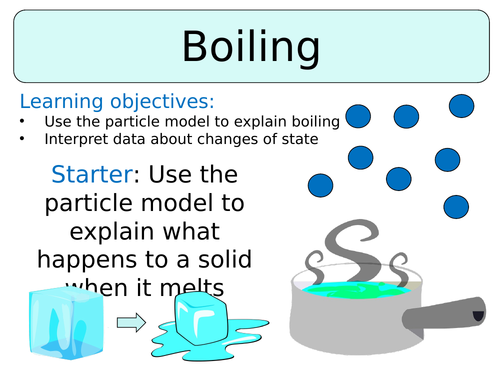
This lesson is designed for the Activate KS3 Science Course, specifically Year 7 C1.1 ’Particles & their Behaviour’
For more lessons designed for KS3 and KS4 please visit my shop at: https://www.tes.com/teaching-resources/shop/SWiftScience.
This lesson begins with a video on the process of ‘boiling’, students will need to answer a set of questions whilst watching the video. Once complete students can self-assess their work using the mark scheme provided.
Students are then shown a method they could use to measure the boiling point of a liquid, they are given tips for what to look out for - e.g. bubbles of gas forming in the liquid and also an increase in temperature which then plateaus at a certain point without increasing further.
Next activity is a ‘progress check’, students are asked to copy and complete a set of sentences to outline the process of boiling. This task can then be marked using the mark scheme provided on the PowerPoint.
The next part of the lesson focuses on an investigation, students are asked to firstly think about why salt might be added to a pan of boiling water when cooking pasta. After a short class discussion, students will need to come up with a prediction of how adding salt to water will affect the boiling point of water - will it make it higher or lower? After making the prediction, students will now conduct the experiment to investigate the effect of salt on the boiling point of water. Results should be written into a results table, followed by plotting a graph of their results and writing a conclusion.
The last section of the lesson focuses on the usefulness of boiling points and melting points of substances for predicting the state they are in. Students are provided with the melting point and boiling point of magnesium and are asked to predict the state of the metal at certain temperatures. This work can be marked and corrected using the mark scheme provided.
Lastly, students are given a set of questions based upon what they have learned so far this lesson, they should indicate the correct answers with either thumbs up, thumbs down or thumb in the middle.
The plenary task requires students to write a list of key words from the lesson.
All resources are included at the end of the presentation. Thanks for looking, if you have any questions please let me know in the comments section and any feedback would be appreciated :)
Get this resource as part of a bundle and save up to 33%
A bundle is a package of resources grouped together to teach a particular topic, or a series of lessons, in one place.
Something went wrong, please try again later.
The link on slide 2 doesn't work
Report this resourceto let us know if it violates our terms and conditions.
Our customer service team will review your report and will be in touch.
